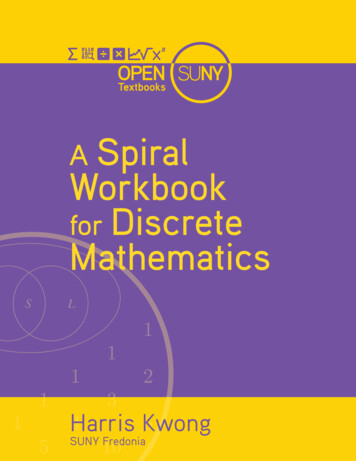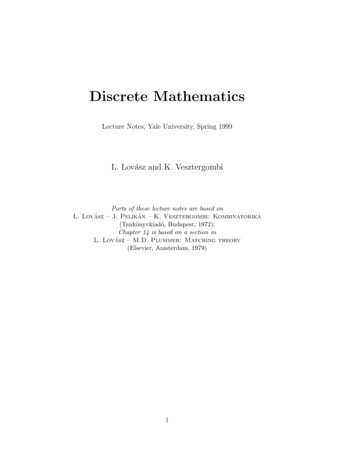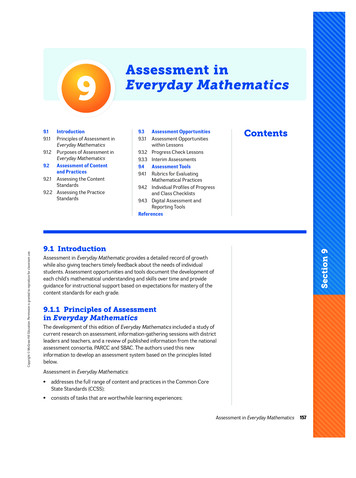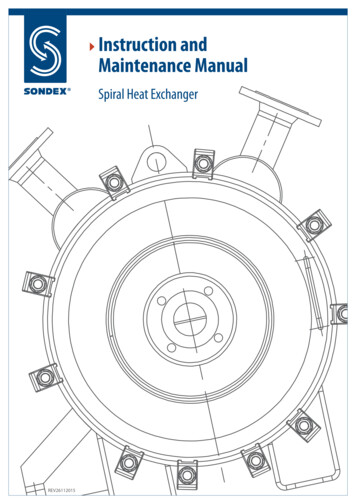
Transcription
A Spiral WorkbookforDiscrete MathematicsHarris KwongDept. of Math. Sci.SUNY FredoniaOpen SUNY Textbooks2015
c 2015 Harris KwongISBN: 978-1-942341-16-1This work is licensed under a Creative Commons Attribution-NonCommercial-ShareAlike 3.0 Unported License.You are free to:Share—copy and redistribute the material in any medium or formatAdapt—remix, transform, and build upon the materialThe licensor cannot revoke these freedoms as long as you follow the license terms. Under the following terms:Attribution—You must give appropriate credit, provide a link to the license, and indicate if changes were made. You may do soin any reasonable manner, but not in any way that suggests the licensor endorses you or your use.NonCommercial—You may not use the material for commercial purposes.ShareAlike—If you remix, transform, or build upon the material, you must distribute your contributions under the same licenseas the original.This publication was made possible by a SUNY Innovative Instruction Technology Grant (IITG). IITG is a competitive grantsprogram open to SUNY faculty and support staff across all disciplines. IITG encourages development of innovations that meetthe Power of SUNY’s transformative vision.Published by Open SUNY TextbooksMilne LibraryState University of New York at GeneseoGeneseo, NY 14454
About the BookA Spiral Workbook for Discrete Mathematics covers the standard topics in a sophomore-levelcourse in discrete mathematics: logic, sets, proof techniques, basic number theory, functions,relations, and elementary combinatorics, with an emphasis on motivation. The text explains andclarifies the unwritten conventions in mathematics, and guides the students through a detaileddiscussion on how a proof is revised from its draft to a final polished form. Hands-on exerciseshelp students understand a concept soon after learning it. The text adopts a spiral approach:many topics are revisited multiple times, sometimes from a different perspective or at a higherlevel of complexity, in order to slowly develop the student’s problem-solving and writing skills.About the AuthorHarris Kwong is a mathematics professor at SUNY Fredonia. He was born and raised in HongKong. After finishing high school there, he came to the United States to further his education.He received his B.S. and M.S. degrees from the University of Michigan, and Ph.D. from theUniversity of Pennsylvania. His research focuses on combinatorics, number theory, and graphtheory. His work appears in many international mathematics journals. Besides research articles,he also contributes frequently to the problems and solutions sections of Mathematics Monthly,Mathematics Magazine, College Journal of Mathematics, and Fibonacci Quarterly. He givesthanks and praises to God for his success.About Open SUNY TextbooksOpen SUNY Textbooks is an open access textbook publishing initiative established by StateUniversity of New York libraries and supported by SUNY Innovative Instruction TechnologyGrants. This initiative publishes high-quality, cost-effective course resources by engaging facultyas authors and peer-reviewers, and libraries as publishing service and infrastructure. The pilotlaunched in 2012, providing an editorial framework and service to authors, students and faculty,and establishing a community of practice among libraries. Participating libraries in the 20122013 pilot include SUNY Geneseo, College at Brockport, College of Environmental Science andForestry, SUNY Fredonia, Upstate Medical University, and University at Buffalo, with supportfrom other SUNY libraries and SUNY Press. To date, the project has published 10 opentextbooks. More information can be found at http://textbooks.opensuny.org.
PrefaceThere are many discrete mathematics textbooks available, so why did I decide to invest my timeand energy to work on something that perhaps only I myself would appreciate?Mathematical writings are full of jargon and conventions that, without proper guidance, aredifficult for beginners to follow. In the past, students were expected to pick them up along theway on their own. Those who failed to do so would be left behind. Looking back, I considermyself lucky. It was by God’s grace that I survived all those years. Now, when I teach amathematical concept, I discuss its motivation, explain why it is important, and provide a lotof examples. I dissect the proofs thoroughly to make sure everyone understands them. In brief,I want to show my students how to analyze mathematical problems.Most textbooks typically hide all these details. They only show you the final polishedproducts. By training, mathematicians love short and elegant proofs. This is reflected in theirown writing. Yes, the results are beautiful, but it is a mystery how mathematicians come upwith such ideas. I want a textbook that discusses mathematical concepts in greater detail. Iwant to teach my students how to read and write mathematical arguments. Since I could notfind a textbook that suited my needs, I started writing lecture notes to supplement the maintext. Marginal notes, hands-on exercises, summaries, and section exercises were subsequentlyadded at different stages. The lecture notes have evolved into a full-length text.Discrete mathematics is a rich subject, full of many interesting topics. Often, it is taught toboth mathematics and computer science majors. Due to the limit in space, this text addressesmainly the needs of the mathematics majors. Consequently, we will concentrate on logic andproof techniques, and apply them to sets, basic number theory, and functions. In the last twochapters, we discuss relations and combinatorics, as many students will find them useful in othercourses.Since the intended audience of the text is mathematics majors, I use a number of examplesfrom calculus. By design, I hope this can help the students review what they have learned, andsee that discrete mathematics forms the foundation of many mathematical arguments.Discrete mathematics is often a required course in computer science. I find it hard andunjust to serve two different groups of students in the same textbook. Although this text couldbe used in a typical first semester discrete mathematics class for the computer science majors,they need to consult another text for the second semester course. Here are two that serve thispurpose well: Alan Doerr and Kenneth Levasseur, Applied Discrete Structures. Miguel A. Lerma, Notes on Discrete Mathematics.Both are available on-line.Why do I call this a workbook? There are many hands-on exercises designed to help studentsunderstand a new concept before they move on to the next. I believe the title Workbook reflectsthe nature of the book, because I expect the students to work on the hands-on exercises. Butwhy spiral? Because the pedagogy is inspired by the spiral method. The idea is to revisitsome themes and results several times throughout the course and each time further deepenyour understanding. You will find some problems pop up more than once, and are solved in adifferent way each time. In other instances, a concept you learned earlier will be viewed from anew perspective, thus adding a new dimension to it.
viPrefaceI am indebted to the anonymous reviewers, whose numerous valuable comments helped toshape the workbook in its current form. I would also like to express my great appreciation toScott Richmond of Reed Library at the State University of New York at Fredonia, who providedmany helpful suggestions and editorial assistance.The reason I developed this workbook is to help students learn discrete mathematics. If thisworkbook proves to be a failure, I am the one to blame. If you find this workbook serves itsintended purposes, I give all the glory to God, in whom I believe and trust.Harris KwongApril 21, 2015
ContentsPrefacev1 An1.11.21.31.4IntroductionAn Overview . . . . . . . . . . . . . .Suggestions to Students . . . . . . . .How to Read and Write MathematicsProving Identities . . . . . . . . . . . .11236.9914172428363 Proof Techniques3.1 An Introduction to Proof Techniques . . . .3.2 Direct Proofs . . . . . . . . . . . . . . . . .3.3 Indirect Proofs . . . . . . . . . . . . . . . .3.4 Mathematical Induction: An Introduction .3.5 More on Mathematical Induction . . . . . .3.6 Mathematical Induction: The Strong Form.434347525866734 Sets4.1 An Introduction . . . .4.2 Subsets and Power Sets4.3 Unions and Intersections4.4 Cartesian Products . . .4.5 Index Sets . . . . . . . .81. 81. 89. 97. 104. 109.1171171191251291371411462 Logic2.1 Propositions . . . . . . . . . . .2.2 Conjunctions and Disjunctions2.3 Implications . . . . . . . . . . .2.4 Biconditional Statements . . .2.5 Logical Equivalences . . . . . .2.6 Logical Quantifiers . . . . . . .5 Basic Number Theory5.1 The Principle of Well-Ordering . . .5.2 Division Algorithm . . . . . . . . . .5.3 Divisibility . . . . . . . . . . . . . .5.4 Greatest Common Divisors . . . . .5.5 More on GCD . . . . . . . . . . . . .5.6 Fundamental Theorem of Arithmetic5.7 Modular Arithmetic . . . . . . . . .
viiiCONTENTS6 Functions6.1 Functions: An Introduction6.2 Definition of Functions . . .6.3 One-to-One Functions . . .6.4 Onto Functions . . . . . . .6.5 Properties of Functions . .6.6 Inverse Functions . . . . . .6.7 Composite Functions . . . .1571571591651711761841897 Relations7.1 Definition of Relations . . .7.2 Properties of Relations . . .7.3 Equivalence Relations . . .7.4 Partial and Total Ordering.1971972012082168 Combinatorics8.1 What is Combinatorics? . .8.2 Addition and Multiplication8.3 Permutations . . . . . . . .8.4 Combinations . . . . . . . .8.5 The Binomial Theorem . . . . . . .Principles. . . . . . . . . . . . . . . .221221222230235243A Solutions to Hands-On Exercises251B Answers to Selected Exercises279Index296
Chapter 1An Introduction1.1An OverviewWhat is discrete mathematics? Roughly speaking, it is the study of discrete objects. Here,discrete means “containing distinct or unconnected elements.” Examples include: Determining whether a mathematical argument is logically correct.Studying the relationship between finite sets.Counting the number of ways to arrange objects in a certain pattern.Analyzing processes that involve a finite number of steps.Here are a few reasons why we study discrete mathematics: To develop our ability to understand and create mathematical arguments. To provide the mathematical foundation for advanced mathematics and computer sciencecourses.In this text, we will cover these five topics:1. Logic and Proof Techniques. Logic allows us to determine if a certain argument isvalid. We will also learn several basic proof techniques.2. Sets. We study the fundamental properties of sets, and we will use the proof techniqueswe learned to prove important results in set theory.3. Basic Number Theory . Number theory is one of the oldest branches of mathematics; itstudies properties of integers. Again, we will use the proof techniques we learned to provesome basic facts in number theory.4. Relations and Functions. Relations and functions describe the relationship betweenthe elements from two sets. They play a key role in mathematics.5. Combinatorics. Combinatorics studies the arrangement of objects. For instance, onemay ask, in how many ways can we form a five-letter word. It is used in many disciplinesbeyond mathematics.All of these topics are crucial in the development of your mathematical maturity. The importanceof some of these concepts may not be apparent at the beginning. As time goes on, you will slowlyunderstand why we cover such topics. In fact, you may not fully appreciate the subjects untilyou start taking advanced courses in mathematics.This is a very challenging course partly because of its intensity. We have to cover manytopics that appear totally unrelated at first. This is also the first time many students have tostudy mathematics in depth. You will be asked to write up your mathematical argument clearly,precisely, and rigorously, which is a new experience for most of you.
2Chapter 1An IntroductionLearning how to think mathematically is far more important than knowing how to do allthe computations. Consequently, the principal objective of this course is to help you developthe analytic skills you need to learn mathematics. To achieve this goal, we will show you themotivation behind the ideas, explain the results, and dissect why some solution methods workwhile others do not.1.2Suggestions to StudentsAll mathematics courses are difficult. It takes hard work and patience to learn mathematics.Rote memorization does not work. Here are some suggestions that you may find helpful:1. Do not skip classes.2. Read the text, including the examples, before the lecture; review what you have learnedafter each lecture.3. Do the exercises.(a) First, study the examples in the book.(b) Make an effort to understand how and why a solution works, and remember howcertain types of problems should be solved.(c) When you do a problem, ask yourself if you have seen something similar before; ifyou have, follow the steps in its solution.(d) After solving a problem, look for alternate solutions, analyze and compare theirdifferences.4. Get help from the instructor, your friends, and whatever facility your college provides.5. Develop good study habits.(a) Keep working every day: study the book, your own lecture notes, and, most importantof all, do the exercises at the end of each section.(b) Form a study group of two to three students, and meet on a regular basis to studytogether.(c) Check the solutions for any nonsense or discrepancies.(d) Learn how to solve the problems systematically.6. Perseverance. Do not give up easily.7. Be willing to help your classmates. Trying to explain something to others is the best wayto learn anything new.Attitude is the real difference between success and failure. Nothing comes easy. To succeed,you have to work hard. But you also need to learn how to learn mathematics the right way. Do not rely on memorizing formulas or procedures by rote. Instead, try to understand theconcepts and ideas behind them. It is important to learn when and how to use them. Of course, it does not mean that you need not memorize anything at all. On the contrary,many basic results and definitions need to be memorized. You may find it helpful to usea highlighter to mark the definitions and keywords that you have trouble recalling, and Iurge you to review them frequently. Do not compartmentalize the material; all sections are connected in one way or another.Consequently, as you move along from chapter to chapter and from section to section, tryto observe the connections between the concepts you have learned. Without saying, it isunderstood that you need to remember what you had learned earlier.
1.3How to Read and Write Mathematics3 Write down all intermediate and partial results clearly. For instance, if the value of x is 7,do not just jot down the number 7; instead, write x 7. Otherwise, you may forget what7 is after just a few minutes. In brief, present your results in such a way that they can beread and understood by everyone in the class. While we are on the subject, let us comment briefly how to write up a solution. Take yourhomework assignments seriously. Keep in mind: to study for a test, you may want toreview your homework, so you need to be able to read your own work. Write everythingclearly and neatly. The process of writing out everything correctly helps you think aboutwhat you write. Very often, incoherent and incomprehensible writing is an indication oflack of understanding of the subject matter. When doing your homework assignments, start with a draft, then look over it carefully,check the spelling and grammar, and revise the solution. Make sure you write in completesentences and use correct notations. If necessary, you may have to polish it further. Beforeturning in the final version, be sure to check again for any mistakes that you may haveoverlooked.How should a student use this workbook?1.2.3.4.1.3Read the workbook before class, and study the workbook again after each class.Read and study the examples in the workbook.Do the hands-on exercises.Do the section exercises.How to Read and Write MathematicsReading mathematics is difficult for beginners. It takes patience and practice to learn how toread mathematics. You may need to read a sentence or a paragraph several times before youunderstand it completely. There are writing styles and notational conventions that you acquireonly by reading and paying attention to how mathematics is written. As we proceed with thecourse, we will discuss the details. As a starter, let us offer several suggestions. Make sure you know the definition of mathematical terms, the meaning and proper usage ofmathematical symbols and notations. Although this may sound obvious, many beginnershave difficulty understanding a mathematical argument because they fail to recall theexact meaning of certain mathematical concepts. Often, the reason behind a claim lies in the sentence before it. Sometimes it could befound in the preceding paragraph, and it is not unusual that you may need to checkseveral sentences or paragraphs before it. You need to take an active role in readingmathematics, and you need to remember what you have read. Mathematicians prefer short and elegant proofs. To do this, they suppress the details ofwhat they consider as “obvious” reasons. But what is obvious to one reader may not bethat obvious to another. At any rate, for practical reasons, it is impossible to include everyminute step in a mathematical argument. Consequently, keep your pencil and paper nextto you, and be ready to check the calculation and fill in the missing details. It may help to try out some examples just to see how an argument works. After you finish reading a proof, go over it one more time, and try to summarize its keysteps (in other words, try to draw an outline of the proof) in your own words.Writing mathematics is even harder! It takes much longer to learn how to write mathematics.Of course, the most important thing about a mathematical argument is its correctness. Whenwe say “good” mathematical writing, we are talking about precision, clarity, and sound logic.
4Chapter 1An Introduction Be precise! For example, do not just say “it” when it is unclear which quantity you arereferring to. This is particularly true in a lengthy argument. In this regard, it helps toidentify and hence distinguish different quantities by their names such as x, y, z, etc. Use mathematical terms correctly! A common mistake is confusing an expression with anequation. An equation has an equal sign, as inx y 5,but an expression does not, as inx y. Likewise, the following is an inequality:x y 5.Do not call it an equation! Do not abuse the word “solve.” For instance, many students would say “solve 52 73 .”A more appropriate saying should be “compute the value of 52 73 ,” or simply “evaluate52 73 .”In the beginning, it helps to follow what others do. This again means you need to read a lot ofmathematical writing, and pick up styles that you are comfortable with. We often follow someconventions (unwritten rules, if you prefer) that everyone follows.Example 1.3.1Consider this argument for showing that (x y)(x y) x2 y 2 :We want to show that(x y)(x y) x2 y 2 .After expanding the product on the left-hand side,we find x2 xy yx y 2 x2 y 2 ,which is what we want to prove.The logic and mathematics in the argument are correct, but not the notation. In formal writing,each equation should be a stand-alone equation. The last equation is incomplete, because it doesnot have anything on the left-hand side of the equal sign. Here is a proper way to write theargument:We want to show that(x y)(x y) x2 y 2 .After expanding the product on the left-hand side,we find(x y)(x y) x2 xy yx y 2 x2 y 2 ,which is what we want to prove.The fix is simple: just repeat the left-hand side.N
1.3How to Read and Write Mathematics5Example 1.3.2 Short and simple mathematical expressions or equations such as a2 b2 c2can be written within a paragraph. Longer ones and expressions or equations that are importantshould be displayed separately, and centered, on their own lines, as inx3 y 3 (x y)(x2 xy y 2 ).If we intend to refer to the equation later, assign a number to it, and enclose the number withinparentheses:x2 y 2 (x y)(x y).(1.1)Now, for example, we can say, because of (1.1), we find135 144 9 122 32 (12 3)(12 3) 9 · 15.For a longer equation such as(x y)2 (x y)(x y) x2 xy xy y 2 x2 2xy y 2 ,it may look better and easier to follow if we break it up into several lines, and line them upalong the equal signs:(x y)2 (x y)(x y) x2 xy xy y 2 x2 2xy y 2 .Although we display the equation in three lines, they together form one equation. The equalsigns at the beginning of the second and third lines indicate that they are the continuation ofthe previous line. Since this is actually one long equation, we only need to say (x y)2 once,namely, at the beginning.When part of the right-hand side extends beyond the margin, you may want to balance thelook of the entire equation by repositioning the left-hand side:(x2 2xy y 2 )(x2 2xy y 2 ) x4 2x3 y x2 y 2 2x3 y 4x2 y 2 2xy 3 x2 y 2 2xy 3 y 4 x4 4x3 y 6x2 y 2 4xy 3 y 4 .In the multi-line display format, always write the equal signs at the beginning of the lines. Donot forget to align the equal signs.When part of the right-hand side is too long to display as a single piece, we may split it intomultiple pieces:(x y)5 (x y)2 (x y)3 (x2 2xy y 2 )(x3 3x2 y 3xy 2 y 3 ) x5 3x4 y 3x3 y 2 x2 y 3 2x4 y 6x3 y 2 6x2 y 3 2xy 4 x3 y 2 3x2 y 3 3xy 4 y 5 x5 5x4 y 10x3 y 2 10x2 y 3 5xy 4 y 5 .It is a common practice to use indentation to indicate the continuation of part of a line into thenext.NThere will be more discussion as we continue. Let us not forget: the best way to learn isto watch and observe how others do it. Reading is a must! Reading and analyzing technicalpapers will surely improve your mathematical knowledge as well as your writing.
6Chapter 11.4An IntroductionProving IdentitiesThere are many methods that one can use to prove an identity. The simplest is to use algebraicmanipulation, as we have demonstrated in the previous examples. In an algebraic proof, thereare three acceptable approaches: From left to right: expand or simplify the left-hand side until you obtain the right-handside. From right to left: expand or simplify the right-hand side until you obtain the left-handside. Meet in the middle: expand or simplify the left-hand side and the right-hand side separatelyuntil you obtain the same result from both sides.Example 1.4.1To prove thatx3 y 3 (x y)(x2 xy y 2 ),we start from the right-hand side, because it is more complicated than the left-hand side. Theproof proceeds as follows:(x y)(x2 xy y 2 ) x3 x2 y x2 y xy 2 xy 2 y 3 x3 y 3 .Remember: start from one side and work on it until you obtain the other side.Example 1.4.2NThe following “proof” ofx4 x2 y 2 y 4 (x2 xy y 2 )(x2 xy y 2 )is incorrect:A wrong proof.x4 x2 y 2 y 4 (x2 xy y 2 )(x2 xy y 2 ) x4 x3 y x2 y 2 x3 y x2 y 2 xy 3 x2 y 2 xy 3 y 4 x4 x2 y 2 y 4 .Here is the reason. When we placex4 x2 y 2 y 4 (x2 xy y 2 )(x2 xy y 2 )at the start of the proof, by convention, we are proclaiming that x4 x2 y 2 y 4 is indeed equalto (x2 xy y 2 )(x2 xy y 2 ). However, this is what we are asked to prove. Before we haveactually proved that it is true, we do not know yet, whether they are equal. Therefore, it iswrong to start the proof with it.NExample 1.4.3For the same reason, the following “proof” of the identityx3 y 3 (x y)(x2 xy y 2 )is unacceptable:Another wrong proof.x3 y 3x3 y 3x3 y 3 (x y)(x2 xy y 2 ) x3 x2 y x2 y xy 2 xy 2 y 3 x3 y 3
1.47Proving IdentitiesBy putting x3 y 3 on the left-hand side of every line, this becomes (by convention) a collectionof three equations. In a nutshell, the argument starts with an equation and we simplify untilwe obtain something we know is true. If this format is valid, we can “prove” that 21 6, asfollows:21 66 2127 27By writing 21 6 at the beginning of the proof, what we really say is “Assume 21 6 is true.”But this is what we intend to prove. Thus, in effect, we are putting the cart in front of thehorse, which is logically incorrect. There is another explanation why this proof is incorrect. Weshall discuss it in Section 2.3.NIn brief: we cannot start with the given identity and simplify both sides until we obtain anequality (or an equation of the form 0 0).Example 1.4.4Show that16k(k 1)(2k 1) (k 1)2 16 (k 1)(k 2)(2k 3).Solution 1:We can use the “meet in the middle” approach. Recall that we cannot simplifyboth sides simultaneously. Instead, we should expand the two sides separately, and then comparethe results. We also suggest adding more writing (in words) to help with the explanation.After expansion, the left-hand side becomes16k(k 1)(2k 1) (k 1)2 136 (2k 13 3k 2 k) (k 2 2k 1)k3 32k2 136k 1.The right-hand side expands into16 (k 1)(k 2)(2k 3) 136 (2k 13 9k 2 13k 6)k3 32k2 136k 1.Since both sides yield the same result, they must be equal.Although the proof is correct, it requires two sets of computation. It is much easier to use eitherthe left-to-right or the right-to-left approach.Solution 2:A better alternative is to start from the left-hand side and simplify it until weobtain the right-hand side. Our secret weapon is factorization:16k(k 1)(2k 1) (k 1)2 16 (k 1)[k(2k 1) 6(k 1)] 16 (k 1)(2k 2 7k 6) 16 (k 1)(k 2)(2k 3).This approach is usually better and safer, because no messy computation is involved.Hands-On Exercise 1.4.1Show thatk(k 1)(k 2)(k 1)(k 2)(k 3) (k 1)(k 2) .33N
8Chapter 1An IntroductionBe sure to use one of the three methods we discussed above.4Summary and Review There are only three ways to prove an identity: left to right, right to left, or meet in themiddle. Never prove an identity by simplifying both sides simultaneously.Exercises 1.41. Let x and y be any real numbers. Prove that(x y)3 x3 3x2 y 3xy 2 y 3 .2. Let x and y be any real numbers. Prove that(a b)4 a4 4a4 b 6a2 b2 4ab3 b4 .3. Prove that, for any distinct real numbers x and y,x3 y 3 x2 xy y 2 .x y4. Prove that, for any integer k,k(k 1)(k 2)(k 3)(k 1)(k 2)(k 3)(k 4) (k 1)(k 2)(k 3) .445. Prove that, for any integer k,k 2 (k 1)2(k 1)2 (k 2)2 (k 1)3 .44
Chapter 2Logic2.1PropositionsThe rules of logic allow us to distinguish between valid and invalid arguments. Besides mathematics, logic has numerous applications in computer science, including the design of computercircuits and the construction of computer programs. To analyze whether a certain argument isvalid, we first extract its syntax.Example 2.1.1These two arguments: If x 1 5, then x 4. Therefore, if x 6 4, then x 1 6 5. If I watch Monday night football, then I will miss the following Tuesday 8 a.m. class.Therefore, if I do not miss my Tuesday 8 a.m. class, then I did not watch football theprevious Monday night.use the same format:If p then q. Therefore, if q is false then p is false.If we can establish the validity of this type of argument, then we have proved at once that botharguments are legitimate. In fact, we have also proved that any argument using the same formatis also credible.NHands-On Exercise 2.1.1last example?Can you give another argument that uses the same format in the4In mathematics, we are interested in statements that can be proved or disproved. We definea proposition (sometimes called a statement, or an assertion) to be a sentence that is eithertrue or false, but not both.Example 2.1.2The following sentences: Barack Obama is the president of the United States. 2 3 6.are propositions, because each of them is either true or false (but not both).N
10Chapter 2Example 2.1.3LogicThese two sentences: Ouch! What time is it?are not propositions because they do not proclaim anything; they are exclamation and question,respectively.NExample 2.1.4Explain why the following sentences are not propositions:(a) x 1 2.(b) x y y x.(c) A2 0 implies A 0.Solution: (a) This equation is not a statement because we cannot tell whether it is true or falseunless we know the value of x. It is true when x 1; it is false for other x-values. Sinc
A Spiral Workbook for Discrete Mathematics covers the standard topics in a sophomore-level course in discrete mathematics: logic, sets, proof techniques, basic number theory, functions, relations, and










